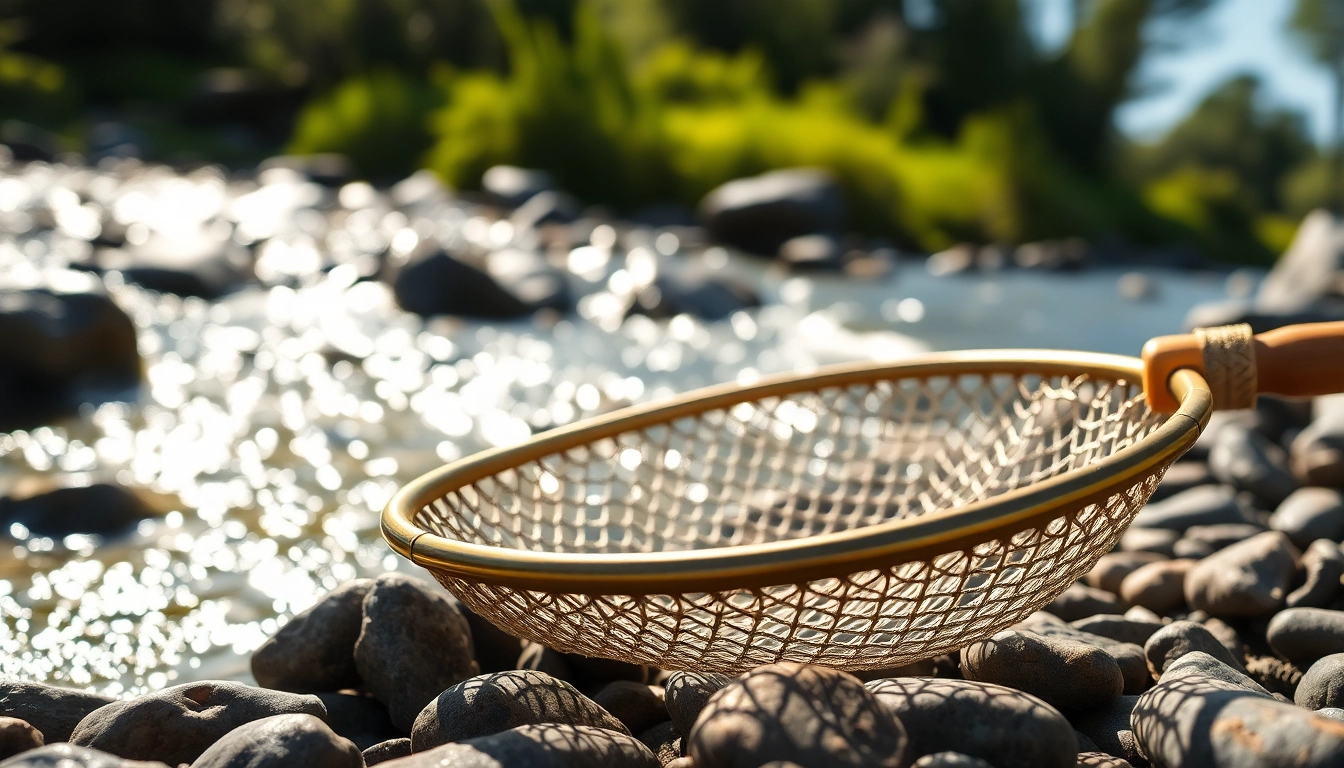Understanding the Importance of a Fly Fishing Net
Fly fishing is not just a hobby; it’s a pursuit that combines patience, skill, and a deep appreciation for nature. One essential tool that can significantly enhance your fly fishing experience is a fly fishing net. While it may seem like a simple accessory, its benefits extend far beyond just landing fish. A well-chosen net can protect your catch and improve your efficiency on the water. Consider investing in a quality fly fishing net as a gateway to a more successful fishing trip.
Benefits of Using a Fly Fishing Net
The primary purpose of a fly fishing net is simple: to assist you in landing your catch. However, the benefits of using a fly fishing net are numerous. Here are some key advantages:
- Minimizes Fish Stress: Using a net allows you to handle fish more gently compared to grabbing them with your hands. This minimizes stress and increases the chances of survival upon release.
- Ease of Use: A net provides a clear advantage when fighting fish, allowing for a smooth transition from water to land, reducing the risk of losing fish due to poor handling.
- Protects the Fish: With a net specifically designed to trap fish without harming them, you can protect their delicate skin and slime layer, crucial for their health.
- Improves Workflow: A fly fishing net streamlines the process of landing and handling fish, making your overall experience more efficient and enjoyable.
- Safe on the Water: An improperly handled fish can flop and fall back into the water, leading to both loss and potential injury to the fish. A net ensures safe handling.
Key Features to Look For
When selecting a fly fishing net, several features should guide your decision-making process:
- Material: The material of the net frame and netting affects durability. Lightweight aluminum or carbon fiber frames offer robustness without excessive weight.
- Netting Type: Rubber nets are gentler on fish and less prone to tangles, while nylon nets can be more affordable but may cause harm to aquatic life.
- Shape and Size: The net should suit your fishing style. A larger, deeper net can be beneficial for bigger fish while a smaller net is appropriate for smaller species.
- Handle Length: Consider handle length based on your fishing environment. Longer handles help in deeper waters while shorter handles are easier to manipulate in tight spaces.
- Grip: A comfortable, non-slip grip is critical for effective handling, especially in wet conditions.
Common Mistakes When Selecting a Fly Fishing Net
Choosing the wrong fly fishing net can diminish your fishing experience. Avoid these common mistakes:
- Neglecting Size: Opting for a net that is too small may result in losing fish, while one that’s too large can be cumbersome to handle.
- Ignoring Material: Failing to consider the netting material may lead to damaging your catch. Prioritize nets designed for sensitive fish types.
- Poor Weight Balance: A net that’s too heavy or unbalanced can make it more difficult to maneuver while fighting fish.
- Disregarding Environment: Not considering the fishing environment— freshwater vs. saltwater—can affect the durability of your net.
- Overlooking Storage and Portability: Many anglers forget to consider how the net will be stored or transported. A collapsible net can save space and be more convenient.
Types of Fly Fishing Nets
Material Options: Nylon vs. Rubber
The choice between nylon and rubber netting is crucial for both performance and the health of your catch. Here’s a breakdown of both:
- Nylon Nets: Generally more affordable and widely available, nylon nets can, however, trap fish more aggressively, potentially harming their protective slime layer. They tend to be less durable once wet.
- Rubber Nets: Although usually pricier, rubber nets are designed with fish-friendly materials, reducing snagging and easier handling, particularly for catch-and-release practices.
Different Shapes and Sizes Explained
Choosing the right shape and size of your fly fishing net enhances not only the landing process but also your overall experience:
- Round Nets: Most commonly used, round nets are versatile and ideal for various fish species.
- Rectangular Nets: Offering more surface area, these nets are suitable for larger catches but can be cumbersome in smaller areas.
- Crucifix Nets: Featuring a unique design, these nets are perfect for catch-and-release fishing, causing minimal harm to fish.
Purpose-Specific Fly Fishing Nets
Depending on your fishing goals, specific nets address various needs:
- Catch and Release Nets: Designed with soft materials to protect the fish during landing.
- Saltwater Nets: Corrosion-resistant nets are perfect for durable use in saltwater conditions.
- Trout Nets: Specifically shaped and sized for catching trout with minimal impact on their health.
Techniques for Using a Fly Fishing Net Effectively
Best Practices for Landing Fish
Landing fish can be a delicate process. Employing these techniques can ensure maximum success:
- Stay Calm: Keep your movements slow and deliberate when bringing a fish near the net.
- Angle the Net: Position the net upstream of the fish when possible to encourage it towards the net.
- Use the Net to Guide: As fish tire, gently scoop them into the net rather than trying to trap them suddenly.
- Protect the Fish: Submerge the net in the water before guiding the fish in to minimize injury.
Maintaining Your Fly Fishing Net
Proper maintenance of your fly fishing net prolongs its lifespan and preserves its efficiency:
- Dry It Well: Always dry your net after use to prevent mildew, especially on nylon versions.
- Inspect Routinely: Regularly check for damages or wear, particularly on the netting and the handle.
- Store Properly: Avoid leaving your net in direct sunlight for prolonged periods as UV can degrade materials.
Storing and Transporting Your Fly Fishing Net
The manner in which you store and transport your fly fishing net can prevent damage while making it easily accessible:
- Collapsible Nets: Opt for collapsible designs for easier transport and storage in limited spaces.
- Dedicated Net Bags: Use padded bags or sleeves for added protection during transport.
- Secure Storage: Avoid placing the net in areas where it may get snagged or crushed.
Comparing Fly Fishing Nets for Performance
Performance Metrics for Different Models
When evaluating different fly fishing nets, consider these performance metrics:
- Weight: A lightweight net is crucial for ease of use, especially during long fishing excursions.
- Durability: Assess how well the net withstands wear and tear from fish, environmental conditions, and transport.
- Ease of Handling: Test how well you can maneuver the net in tight spots or fast-moving waters.
- Water Resistance: The ability of the net material to resist water damage will also enhance longevity.
User Reviews and Recommendations
Consulting user reviews is invaluable in finding the right fly fishing net. Look for feedback on:
- Real-life Usage: Experiences shared by other anglers provide insights into performance in various conditions.
- Customer Service Feedback: Understanding brand reputation can help gauge quality and support.
- Durability and Longevity Reports: Learn how nets hold up over time through user testimonials.
Budgeting for a Quality Fly Fishing Net
Quality fly fishing nets come in a range of prices. Here’s how to budget effectively:
- Understand Your Needs: Identify the features that matter most to you and your fishing style to guide your investment.
- Expect to Spend: Quality nets may require a higher initial investment but will pay off in durability and performance.
- Watch for Sales: Timing your purchase during sales can help you secure a quality net at a better price.
Where to Buy the Best Fly Fishing Nets
Online Retailers vs. Local Shops
When searching for your ideal fly fishing net, you’ll have options between online retailers and local specialty shops:
- Online Retailers: Often provide a broader selection and the convenience of comparing multiple models quickly.
- Local Shops: Allow for hands-on investigation of nets, enabling you to evaluate the size, weight, and grip firsthand.
Evaluating Customer Service and Warranty Options
Before making a purchase, consider the following aspects of customer service and warranty:
- Return Policies: A favorable return policy can give you peace of mind if the net doesn’t meet your expectations.
- Warranty Length: Review warranty details to understand what’s covered in the event of manufacturing defects or damage.
- Customer Support Availability: Ensure that the retailer offers responsive support for questions and concerns.
Seasonal Sales and Discounts to Consider
Timing your purchase during seasonal sales can greatly reduce costs. Here’s when to look:
- End of Season Sales: Many retailers offer discounts when transitioning between fishing seasons.
- Holiday Sales: Events like Black Friday or Memorial Day can be prime opportunities for deals.
- Clearance Events: Keep an eye out for clearance events as new models are released to get quality nets at lower prices.



